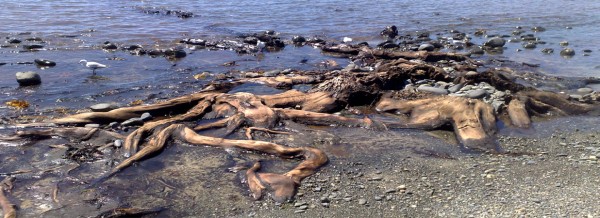Fossilised Forest
Below the surface of Titahi Bay Beach lies an ancient forest...

Photo by Judy Tuck
At low tide at Titahi Bay Beach you can see the remains of a forest that grew here about 100,000 years ago. The forest was a mix of rimu, totara and kahikatea and most likely nikau palms, tree ferns, sedge, flax and raupo, with the size of the stumps showing that the trees grew to a large size. The petrification process that, over a long time, created the fossil wood has preserved the structure of the original trees.
The forest fossilized in situ, meaning that this was where it grew, rather than being transported from somewhere else. The trees grew in a swampy environment during the last warm Inter-glacial period, then the climate warmed and seawater flooded the vegetation and caused sediment to accumulate around the remaining larger vegetation types, promoting preservation. The broken off tree stumps on the beach today may have been buried by many metres of sediment with the sea level rising considerably higher than today.
Sea level rises since fossilisation has eroded the coastline and uncovered the fossil beds. The fossil trees sit in old gravelly, silt and peat beds that are around 10 metres deep and are underlain by a deeper greywacke basement - the same rock as in the headlands of the Bay.
The tree stumps along the entire beach are only clearly exposed for extended periods about once every ten years. Conserving the fossil forest is important as it provides clues as to what the climate was like and how forests grew 100,000 years ago. The best time to see the fossil forest is at low tide during spring when northwest storms have scoured sand from the beach.
Next: Boatsheds